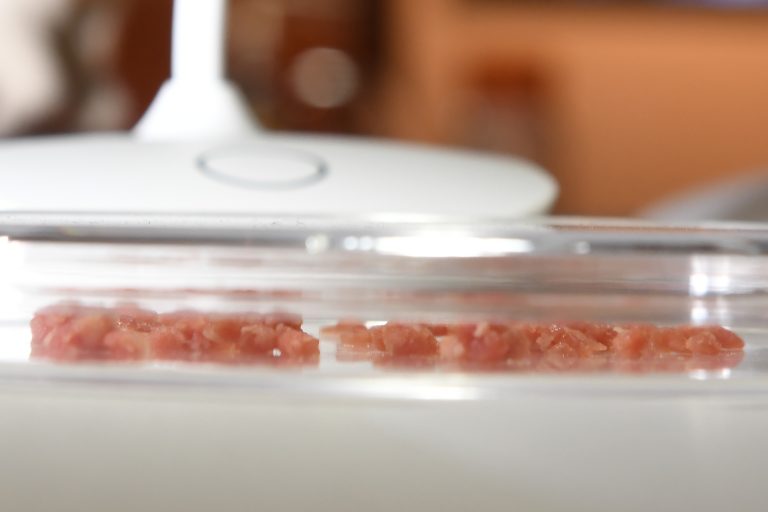The lab-grown meat industry has attracted billions in investment from tech giants like Bill Gates and Richard Branson as well as traditional meat producers including Tyson Foods Inc. and Cargill Inc., who are all betting on a future devoid of factory farming. However the industry is facing significant hurdles as it tries to break into the $1 trillion global meat market including scalability and market acceptance.
Currently, Singapore is the only country that allows the sale of lab-grown meat to consumers and is the sole customer for Eat Just Inc. an Alameda California company who sells under 5,000 pounds of its hybrid cultivated chicken to the country each year.
For comparison, the global meat production market is expected to produce upwards of 350 million metric tons in 2023.
While the industry has been successful in producing small amounts of meat products, producing larger quantities, at a reasonable price, has been allusive.
These products are typically produced by placing poultry and livestock cells into stainless-steel tanks, otherwise known as bioreactors, where the cells are given nutrients and oxygen to grow.
Success
You are now signed up for our newsletter
Success
Check your email to complete sign up
Josh Tetrick, chief executive officer of Eat Just Inc. recently told the Wall Street Journal (WSJ), “We can make it on small scales successfully. What is uncertain is whether we and other companies will be able to produce this at the largest of scales, at the lowest of costs within the next decade.”
‘Like putting a man on the moon’
Uma Valeti, chief executive officer for Upside Foods, another company vying to bring lab-grown meat to market, told the WSJ, “What we’re trying to do is not easy. It’s like putting a man on the moon. There’s no road map or blueprint.”
Late last year the Food and Drug Administration (FDA) said that the meat Upside Foods produces is safe to eat, eliminating a key regulatory hurdle for the company.
“The world is experiencing a food revolution and the FDA is committed to supporting innovation in the food supply,” FDA Commissioner Robert Califf and Susan Mayne, the director of the Center for Food Safety wrote at the time.
Once approval is received from the Agriculture Department, Upside Foods intends to serve its first commercial product, a chicken filet, at a three-star Michelin restaurant in San Francisco.
However, according to a former employee of Upside Foods, the company is struggling to produce large quantities of its product saying that the company even struggled to produce enough meat for lab analysis and tastings, the WSJ reported.
In an attempt to grow at scale the company has dispensed with bioreactors and instead is experimenting with growing the product in two-liter plastic bottles, known as “roller bottles,” similar to what is used by pharmaceutical companies.
Hundreds of these bottles are required to make a few filets.
David Humbird, a chemical engineer skeptical of the industry believes “Roller bottles aren’t scalable. Too small, too labor-intensive,” however Upside Foods says the process works, for small scale production.
Upside Foods’s pilot plant, which ultimately aims to produce 400,000 pounds of product, is not yet fully operational and has failed to reach its interim goal of producing just 50,000 pounds. Company executives say that production will accelerate once the company receives USDA clearance.
READ MORE:
- ‘We’re at the cusp of a food revolution,’ Claims Prolific Tech Entrepreneur
- Italy Bans Synthetic Meat, Fish, and Dairy to ‘Protect Our Culture and Our Tradition’
- Bill Gates Wants Rich Nations to Eat Synthetic Beef
Investors hopeful
Investors remain hopeful however; comfortable with their long-term bets.
Investor, Priti Youssef Choksi, a partner at Norwest Venture Partners told the WSJ, “There’s never a clear timeline that’s exact or crystal ball on how something new to the world progresses.”
Others say that if the globe wants to reach goals to combat climate change, which were laid out in the Paris climate agreement, lab-grown meat, produced at scale, is a requirement.
“If alternative proteins are not successful, the Paris climate agreement goals are probably impossible,” Bruce Friedrich, president of the Good Food Institute, told the WSJ.
According to the Good Food Institute (GFI), a non-profit focused on promoting sustainable proteins, more than $300 billion was invested in the industry in 2022.
One of the first lab-grown meat products ever produced was by Mosa Meat in 2013, that grew a hamburger patty in a lab. The problem was that the patties cost hundreds of thousands of dollars to produce.
Costs to produce the products have been steadily declining over the past decade however are still not at a point where they could compete in the traditional market.
















